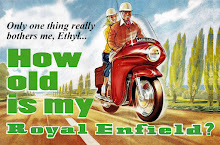The Vintagent Classics: Little Fauss and Big Halsy
-
I was going faster than I ever went in my whole life, then I fell off.
The post The Vintagent Classics: Little Fauss and Big Halsy first appeared
on The V...
IL 500 Custom
CA 1956 Trailblazer
TX 1959 Patrol Car
Royal Enfield Photo of the Week
Women racing for Royal Enfield

2026 Build Train Race applications are open for spots on the women's racing series in road racing and flat track. RideApart
UT 2017 GT 535
New Scram 440 vs. the Scram 411
MA 1959 Trailblazer
WA 2011 G5
Royal Enfields were Indians in '50s

For sale on eBay: ads from the 1950s show Royal Enfields being marketed as U.S. Indian motorcycles. eBay
Everyone loves the retro Bear 650
Classic Vs. Classic, 350 Vs. 650 twin
Can he start it? Bullet idle 6 years

Paul Henshaw pulls a 350 Royal Enfield out of the shed and tries to start it. Can he? Watch: YouTube
PA 1970 Interceptor
Dan Holmes DRS racer for sale
Friday, September 9, 2016
Are Royal Enfield motorcycles Indian enough for India?
What is good for me is not necessarily good for India, of course. So, when a blog item in The Times of India suggests such artifacts of the past as my Royal Enfield may be unhelpful to India, I'm compelled to consider that possibility.
Blog author Francois Gautier describes himself as French, but he obviously knows more about India than I do. He is prepared to point fingers.
"It is probably the British colonization that blunted for good the Indian innovation spirit," he asserts.
"...Take the manufacturing sector, for instance, since Independence, India has often copied English models, such as the Ambassador car, the Royal Enfield Bullet, or the Raleigh cycle, selling them at huge profits for decades and never caring much to improve them."
Gautier's argument, I take it, is that India must innovate from its own strengths to prosper in the modern world.
Makes sense. Take what you have and build on it.
And so, he asks:
"What is that Indian-ness then? And what to do so that Indians become innovators again and not copiers anymore?"
Unfortunately, his solutions are not innovative. He suggests, in effect, that India celebrate its own national history, heroes, religion, sports stars and business spirit. His proof that this will spur innovation seems to be based on the argument that it worked for France.
"...Napoleon is known in India."
In all, I think he's a bit harsh. Napoleon is a special case. So is India.
Today, Royal Enfield is taking steps to insert itself into international markets. Surely a good thing.
In an effort to gain traction globally, the new Continental GT certainly trades on the motorcycle's British heritage. Maybe not innovative design, but smart marketing, I think.
And now the new Himalayan model seems to me to be a pure example of India building on its own strengths (and geography) to innovate.
Subscribe to:
Post Comments (Atom)






















those curly bits on the 'E" and the 'D" remind me of a pair of cats with their backs to us, and their tails curled around them!
ReplyDeleteScaleyback